How to say “Thank You” in Spanish (and 42 Other Ways to Show Your Appreciation)
The basic way to say “thank you” in Spanish is “gracias,” and like in English, there are many other ways to express gratitude.
In fact, gracias is one of the most common words in Spanish, so it’s an important one to master! And if you want to avoid being thought of as a rude person, you’ll absolutely need to learn how to say “thank you” in Spanish!
As for me, I’m a globe-trotting American who has spent most of my adult life overseas. I’m a language teacher and writer, and I’ve spent over 5 years studying Spanish.
So in this article, I’ll teach you several ways to express your gratitude in Spanish.
Table of contents
- All about “ Gracias ”: “Thank you” in Spanish
- “Thank you very much” in Spanish
- Other phrases to use with gracias
- How to thank specific people
- Other ways to thank in Spanish
- How to use agradecer – “to thank”
- How to use apreciar – “to appreciate”
- How to use amable – “kind”
- “Thank you for your business” in Spanish
- Gracias por : Thanks for other things in Spanish
- Conclusion: Don’t be afraid to show your appreciation!
All about “Gracias”: “Thank you” in Spanish
How do you say “thank you” in Spanish? As I mentioned above, a simple gracias will suffice. It can be used in formal or casual settings. So it can also mean “thanks” in Spanish! Now, if you want to level up your Spanish, there’s a lot more that you can do with this single word!
First, let’s make sure we can pronounce gracias correctly.
Notice that we spell “thank you” in Spanish with a C in the middle. That means odds are, if you’re in Latin America, that C will make an “s” sound. But if you’re in Spain, chances are that you’ll hear them pronounce it with a “th”!
But don’t worry – natives will understand either one, so you can choose the sound that’s right for you.
“Thank you very much” in Spanish
Gracias forms the foundation of how to say “thank you very much” in Spanish. The first way to say “thank you very much” in Spanish is muchas gracias, or “many thanks.” Easy!
Remember that gracias can be used in formal and informal situations. So muchas gracias could actually be translated as “thank you very much” or as “thanks a lot”!
We can also level up our gratitude by saying muchísimas gracias. The difference between muchas gracias and muchísimas gracias doesn’t have a direct equivalent in English, but the latter shows more enthusiasm. It’s like saying, “Thank you so much.”
Now, there are a few more way we can dress up gracias with M words to show a ton of appreciation. You can also say mil gracias, which literally translates into “a thousand thanks.” Or if a thousand isn’t enough, you can say un millón de gracias, which we can translate as “thanks a million”!
Other phrases to use with gracias
Of course, these are not the only ways you can dress up gracias! Here are a few more phrases.
Gracias por todo means “thanks for everything.” If someone has done a lot for you, this is a great choice! You can also use gracias por followed by a noun or a verb in the infinitive for something more specific.
For example, gracias por escucharme is how you would say “thank you for listening to me” in Spanish. In addition, gracias por su negocio is one way to say “thank you for your business.” (Stay tuned, you’ll get even more options for both gracias por and “thank you for your business” in a bit!)
Now, if there are multiple people involved, you can say gracias a todos, which means “thank you, everyone.”
You can also combine gracias por todo and gracias a todos with some of the modifiers from the above section. For example, to express a lot of appreciation to everyone, you can say muchas gracias a todos! (Remember to keep the personal a in there!)
To continue, gracias de todos modos or gracias igual is like “thanks anyways.” Use this if someone has tried to help you but didn’t succeed. It’s good to show appreciation for their help in any case!
On the other hand, if you want to be a bit cheeky (or rude), you can say gracias por nada. This means “thanks for nothing.” You can use it when you want to show your non-appreciation toward someone. But hopefully you won’t need to use it much!
Finally, when you want to politely turn something or someone down, you can say No, gracias. This means, “No, thank you” – just like what we say in English!
“Thank you” in Spanish – Phrase List
Here’s a recap of what we’ve learned so far in this section about how to say “thank you” in Spanish:
- Gracias – thank you
- Muchas gracias – thank you very much / thanks a lot
- Muchísimas gracias – thank you so much
- Mil gracias – thank you very much (literally “a thousand thanks”)
- Un millón de gracias – thanks a million
- Gracias por todo – thanks for everything
- Gracias a todos – thanks to everyone
- Gracias igual or gracias de todos modos – thanks anyway
- Gracias por nada – thanks for nothing
- No, gracias – no, thank you
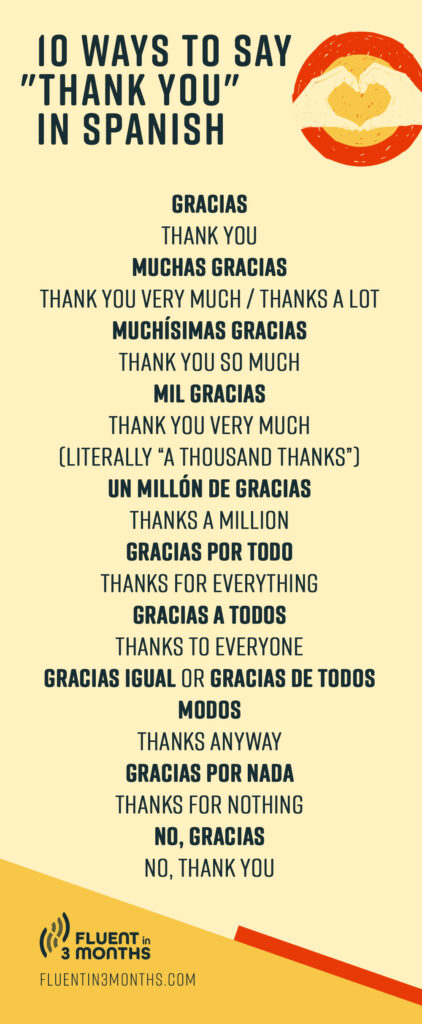
How to thank specific people
Wondering how to thank specific people, like how to say “thank you, my love” in Spanish? It’s super easy! You just identify them after gracias.
For example, “thank you, my love,” is gracias, mi amor.
Other useful phrases are:
- Gracias, mi amigo or gracias, mi amiga, which mean “thank you, my friend.” (Use the former for a male friend, and the latter for a female!)
- Gracias, mi hermano or gracias, mi hermana means “thank you, my brother” and “thank you, my sister,” respectively. You can use this with your literal sibling or with a very close friend!
Want to add a person’s name? Simple! You can just add their name at the end, like gracias María for “thanks, Maria.”
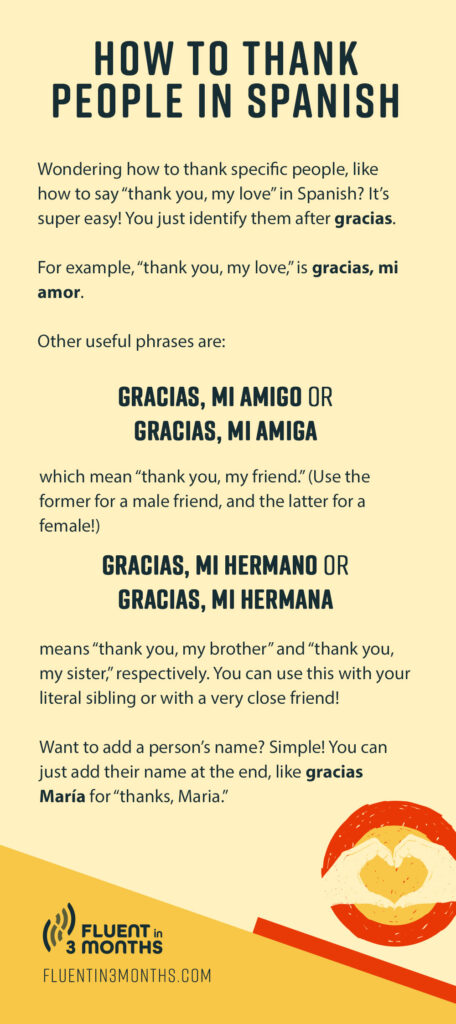
Other ways to thank in Spanish
Of course, there are many other ways to give thanks in Spanish. Here are some key words and how to use them to expand your vocabulary.
How to use agradecer – “to thank”
You can use the verb “agradecer” to show your appreciation in Spanish. It literally means “to thank,” but it’s used similarly to how we would say “appreciate.” You would use this verb in somewhat formal situations.
Keep in mind that it has a slightly irregular conjugation in the yo (first person singular) form, so it turns into yo agradezco.
Now, to use it in a simple sentence, you can say either te lo agradezco or se lo agradezco for “I appreciate it” or, literally, “I thank you.” The former is when you are thanking tú, or a single person you know well and can speak casually to. The latter is for usted or ustedes, so either a single person you speak formally to or the plural “you.”
Of course, depending on what Spanish speaking region you’re in, there may still be other options. If you still have some questions about this, check out our guide on Spanish pronouns!
You can also get more creative with agradecer. For example, you can also say Te / le agradezco la ayuda, for “I appreciate your help.”
If you are beyond words, you can tell someone no puedo agradecerle lo suficiente, or “I can’t thank you enough.”
In relation, there’s also a similar adjective you can use instead of the verb. That is agradecido and agradecida, which means “thankful.” So you can say Estoy agradecido or estoy agradecida to say, “I’m thankful.” And if you’re “very” thankful, throw in a muy to make estoy muy agradecido / agradecida.
To show extreme appreciation, you can say Estoy más que agradecido / agradecida, which means, “I am beyond grateful.”
Also, like the above, if you want to say what more specifically you are thankful for, you can add por. For example, you can say estoy agradecido / agradecida por tu / su ayuda for “I am thankful for your help.”
How to use apreciar – “to appreciate”
Now, I told you agradecer often translates into “appreciate” in English. Apreciar is a literal translation for “to appreciate,” but it’s just less commonly used when giving thanks compared to agradecer. Apreciar also means “to appreciate” in a sense of valuing something, like if you “appreciate” honesty in a person or “appreciate” someone’s advice. It’s a good one to learn if you’re trying to expand your vocabulary!
It’s a regular verb, but you can’t use it on its own. In other words, you need to show what you are grateful for. For example, you could say aprecio tu / su tiempo for “I appreciate your time.” You can also use it with more complex sentences, like aprecio lo que estás tratando de hacer por mí, or “I appreciate what you’re trying to do for me.”
How to use amable – “kind”
Many phrases showing thanks in Spanish use the adjective “amable” or something similar. It means “nice” or “kind.” You can use it in phrases like:
- Qué amable – “How kind.” You can add de tu / su parte or eres/es at the end to say, “How kind of you” and “How kind you are,” respectively.
- Es muy amable (de tu / su parte) – “That’s very kind of you.” This is a similar construction as the first!
- Eres muy amable or es muy amable – “You are very kind.” (The former is for tú. The latter is for usted)
- Muy amable – “Very kind [of you].” This is similar to the above, but it’s lost its meaning a bit from overuse, so now it’s kind of like a less heartfelt, throwaway “thanks.”
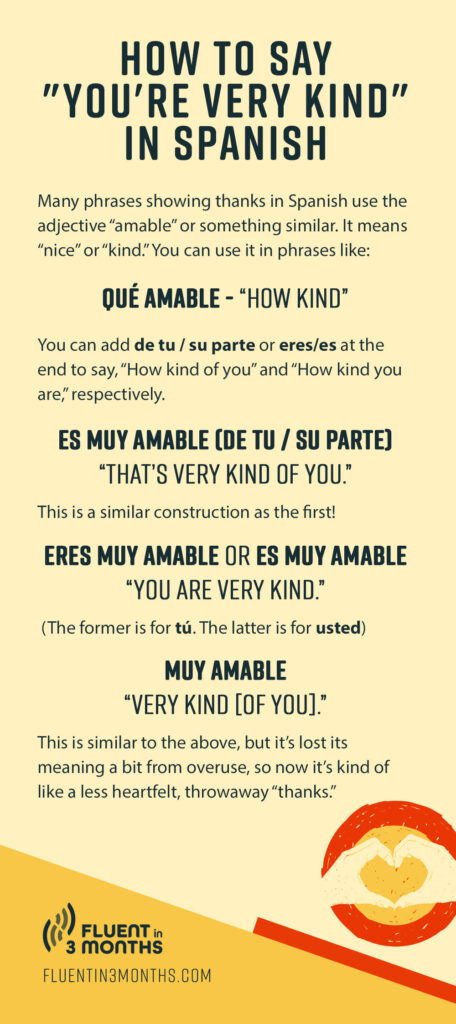
Now, there are other Spanish adjectives that also mean “kind” or “nice”. You can sometimes shake up your vocabulary with replacing amable with the following:
- Atento / Atenta – “thoughtful”
- Bondadoso / bondadosa – “charitable”
- Considerado / considerada – “considerate”
- Cortés – “courteous”
- Dulce – “sweet”
- Generoso / generosa – “generous”
- Gentil – “pleasant”
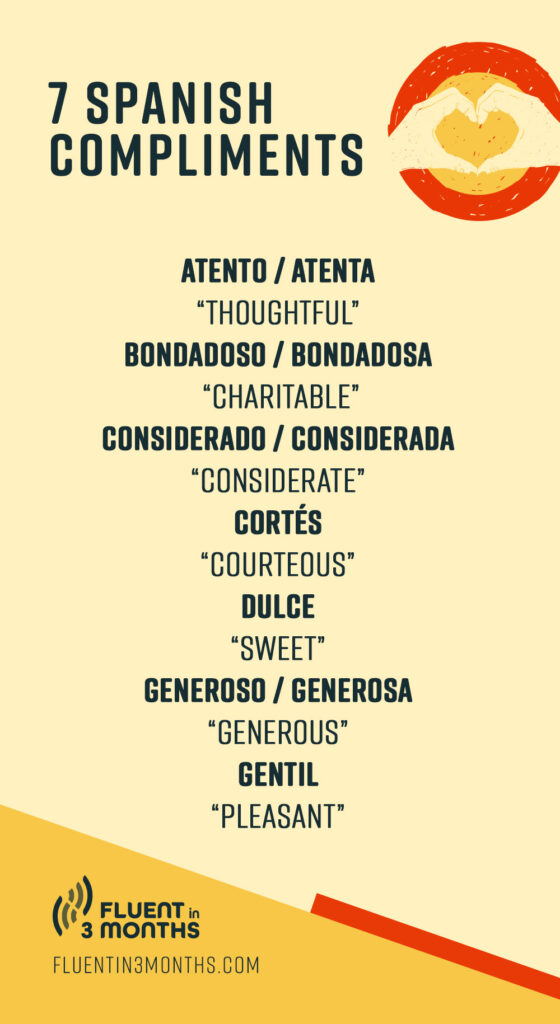
Although be careful! Gentil is often used sarcastically – like saying “how kind of you” with an eyeroll.
“Thank you for your business” in Spanish
So we already learned one way to say “thank you for your business” in Spanish. Knowing Spanish for clients is very important, so we’ll learn a few more options now!
Remember that gracias por su negocio is the basic phrase for “thank you for your business” (literally, thank you for your “business”). Depending on the situation, we can also say:
- Gracias por sus compras – literally, “thank you for your purchases”
- Gracias por su pedido – literally, “thank you for your order”
- Gracias por su aportación – literally, “thank you for your contribution”
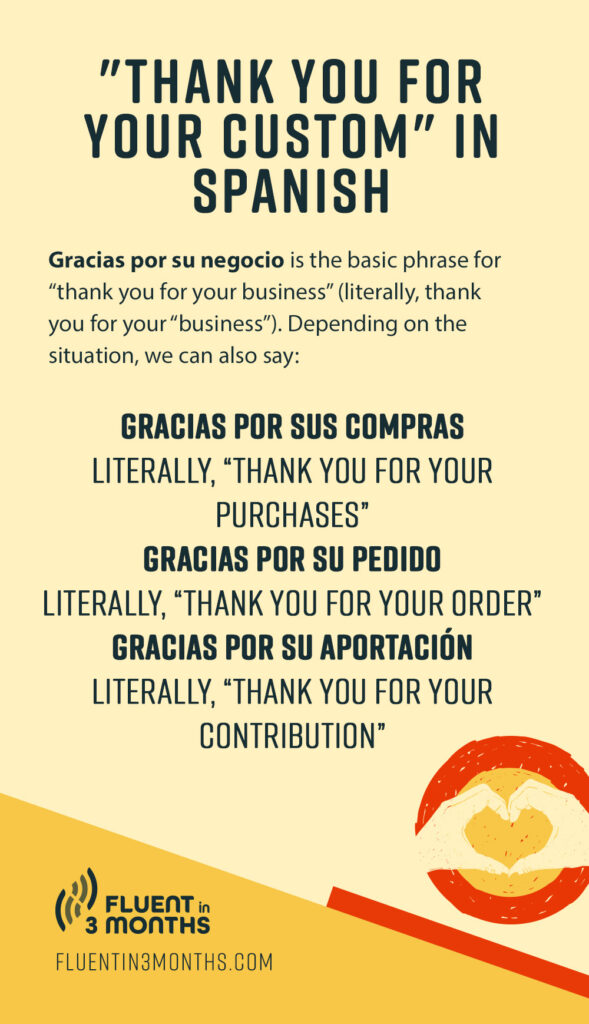
You can also use some of the verbs we learned above to thank someone for their business. For example, you can also say:
- Apreciamos su negocio – “We appreciate your business”
- Agradecemos que haga negocios con nosotros – “We appreciate you doing business with us”
The above was conjugated into the nosotros (“we”) form of a verb, but if you’re a sole trader, you can always use the yo form (aprecio and agradezco).
Gracias por: Thanks for other things in Spanish
We already have quite a list of things to be thankful for! But I know I may not have covered everything you might want to thank someone about. So to wrap up, here’s a list of other things you might want to show appreciation for using gracias.
Keep in mind that for simplicity’s sake, I’ll use the usted form of the examples here, but remember you can use them all with tú and other pronouns also!
Gracias por + nouns
Here are some common phrases with gracias por with nouns:
- Gracias por su apoyo – “thank you for your support”
- Gracias por su arduo trabajo – “thank you for your hard work”
- Gracias por su atención – “thank you for your attention [to an announcement]”
- Gracias por su ayuda – “thank you for your help”
- Gracias por su comprensión – “thank you for your understanding”
- Gracias por las felicitaciones por mi cumpleaños – “thank you for the birthday wishes”
- Gracias por el regalo – “thank you for the gift”
- Gracias por su servicio* – “thank you for your service”
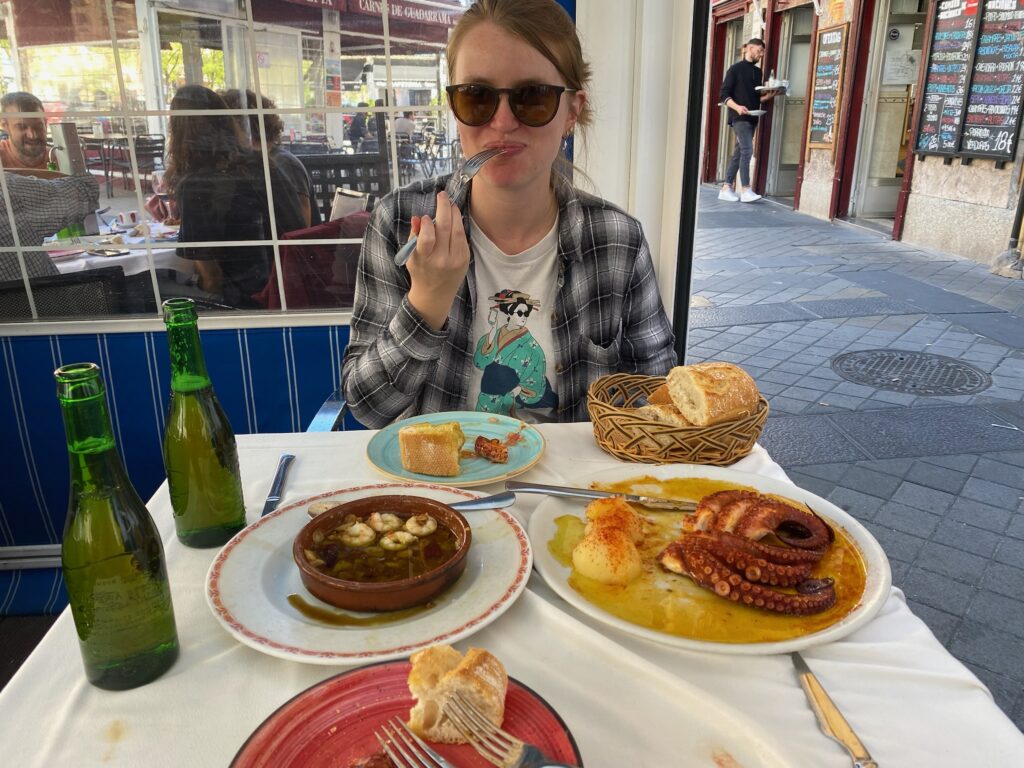
I wanted to tell the chef in Madrid here, Gracias por la buena comida! (“Thank you for the good food!”)
Gracias por + verbs
Here are some common phrases with gracias por with verbs:
- Gracias por darme un aventón – “thanks for giving me a lift”
- Gracias por escribirme* – “thanks for writing”
- Gracias por escucharme – “thanks for listening to me”
- Gracias por preguntar – “thanks for asking”
- Gracias por ser un buen amigo / amiga – “thank you for being a good friend”
- Gracias por venir – “thank you for coming”
Conclusion: Don’t be afraid to show your appreciation!
Of course, the things we can thank people for are endless! So what are you thankful for? I hope you can express it in Spanish now! Keep learning, and keep showing appreciation for all those who help you out.

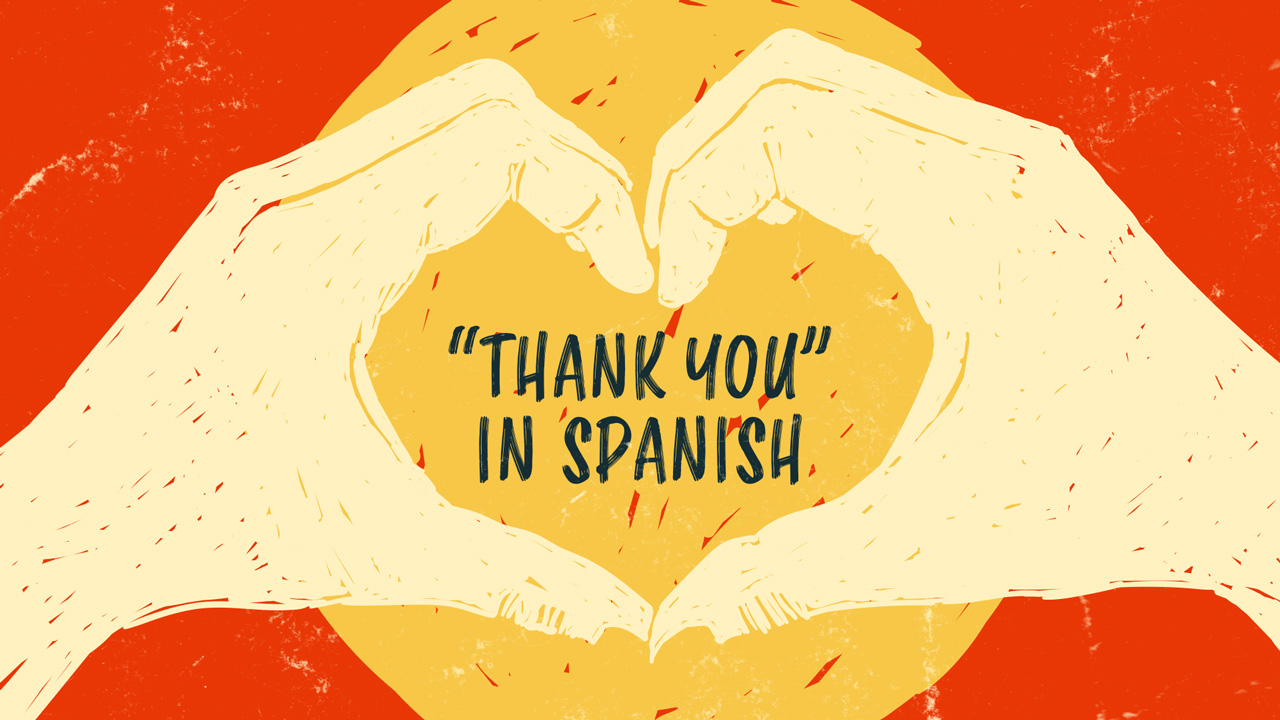

Social